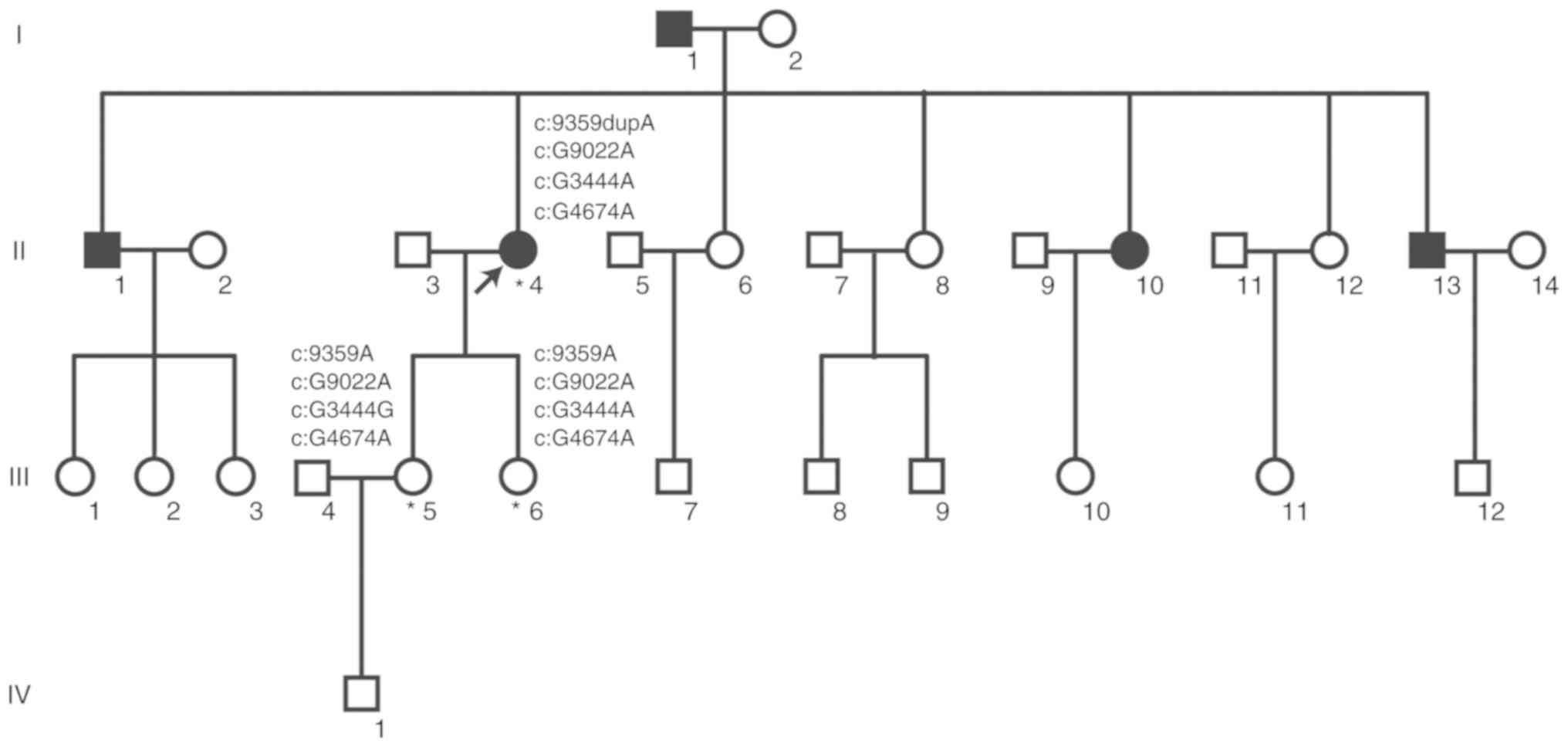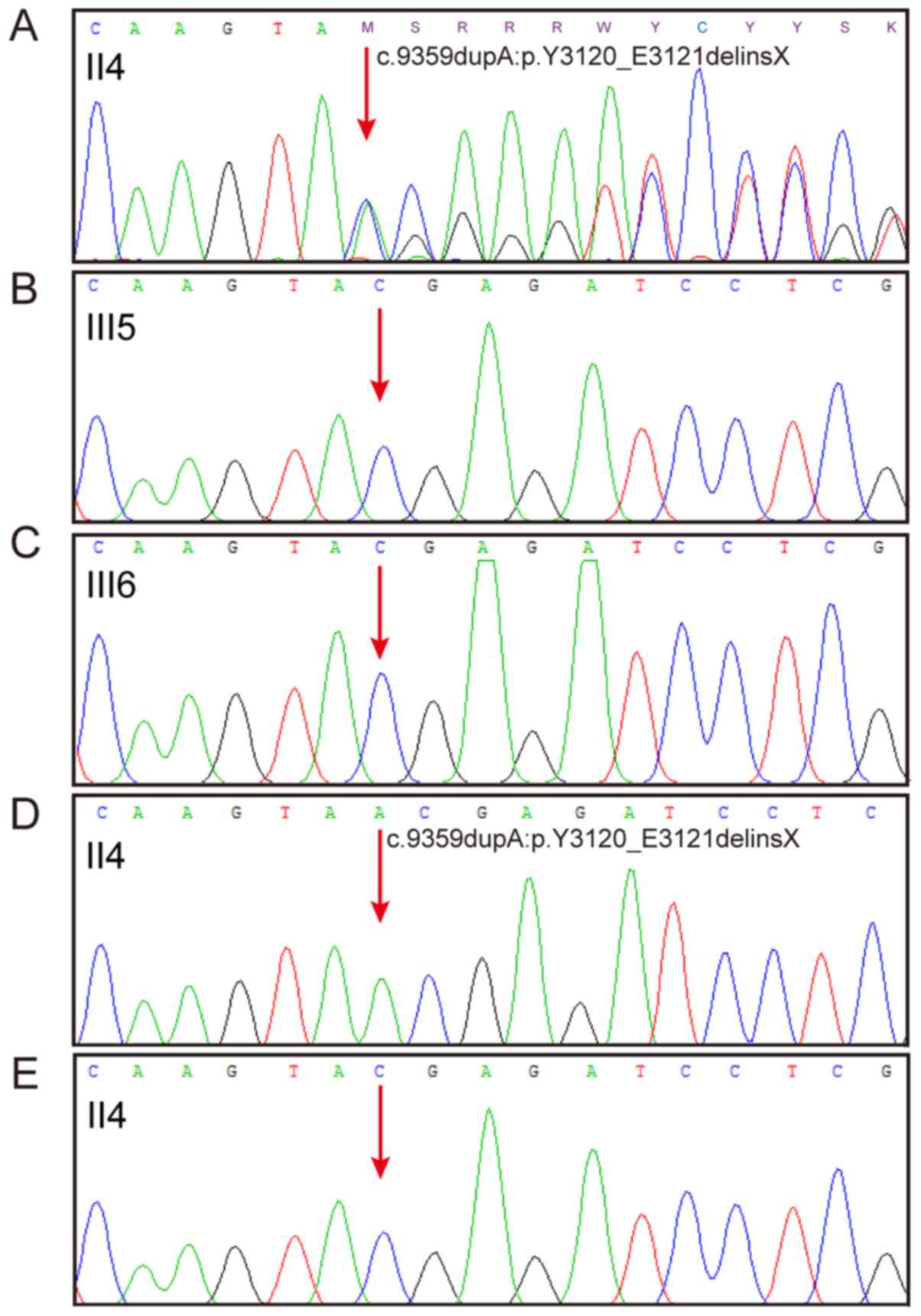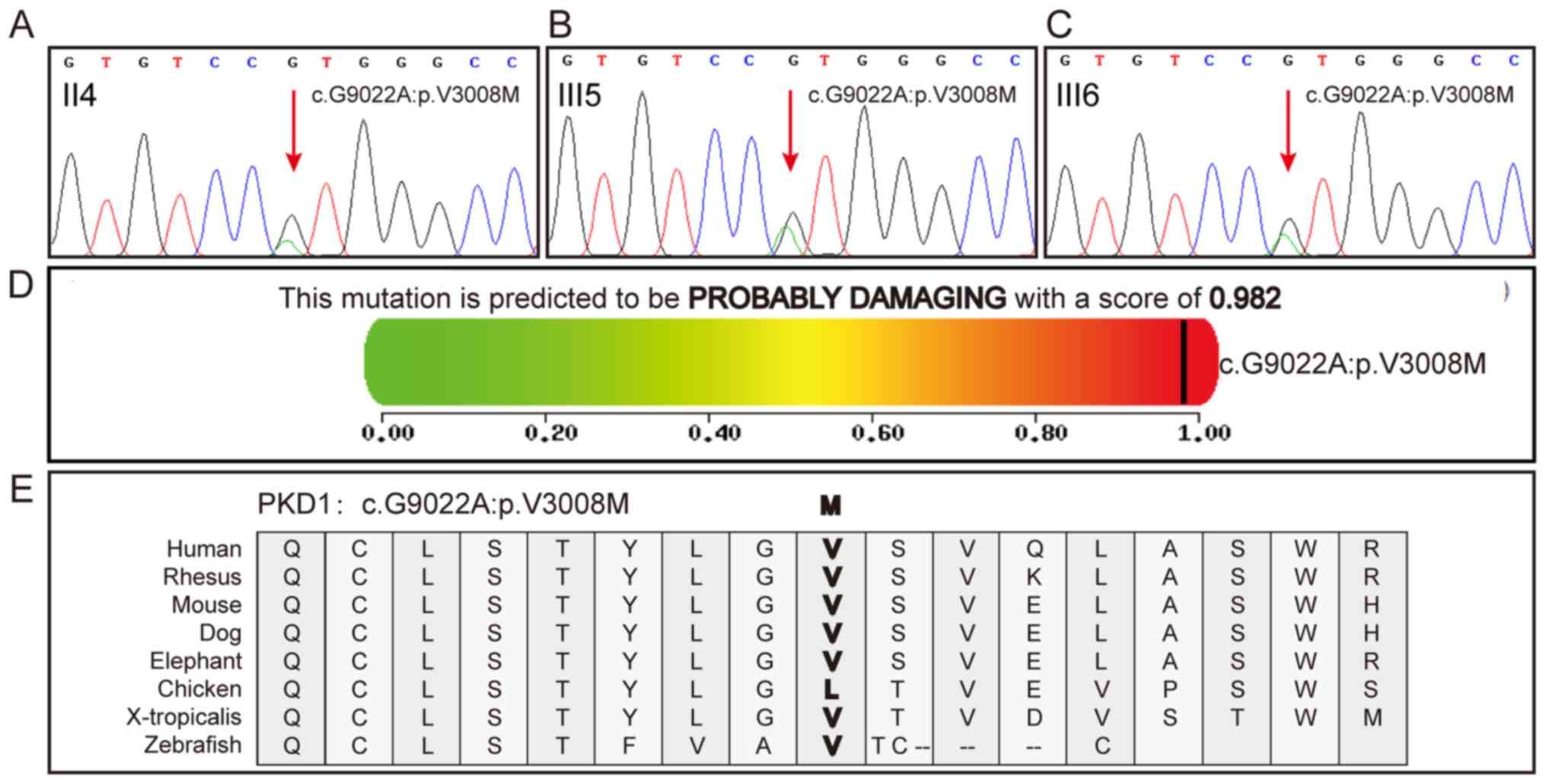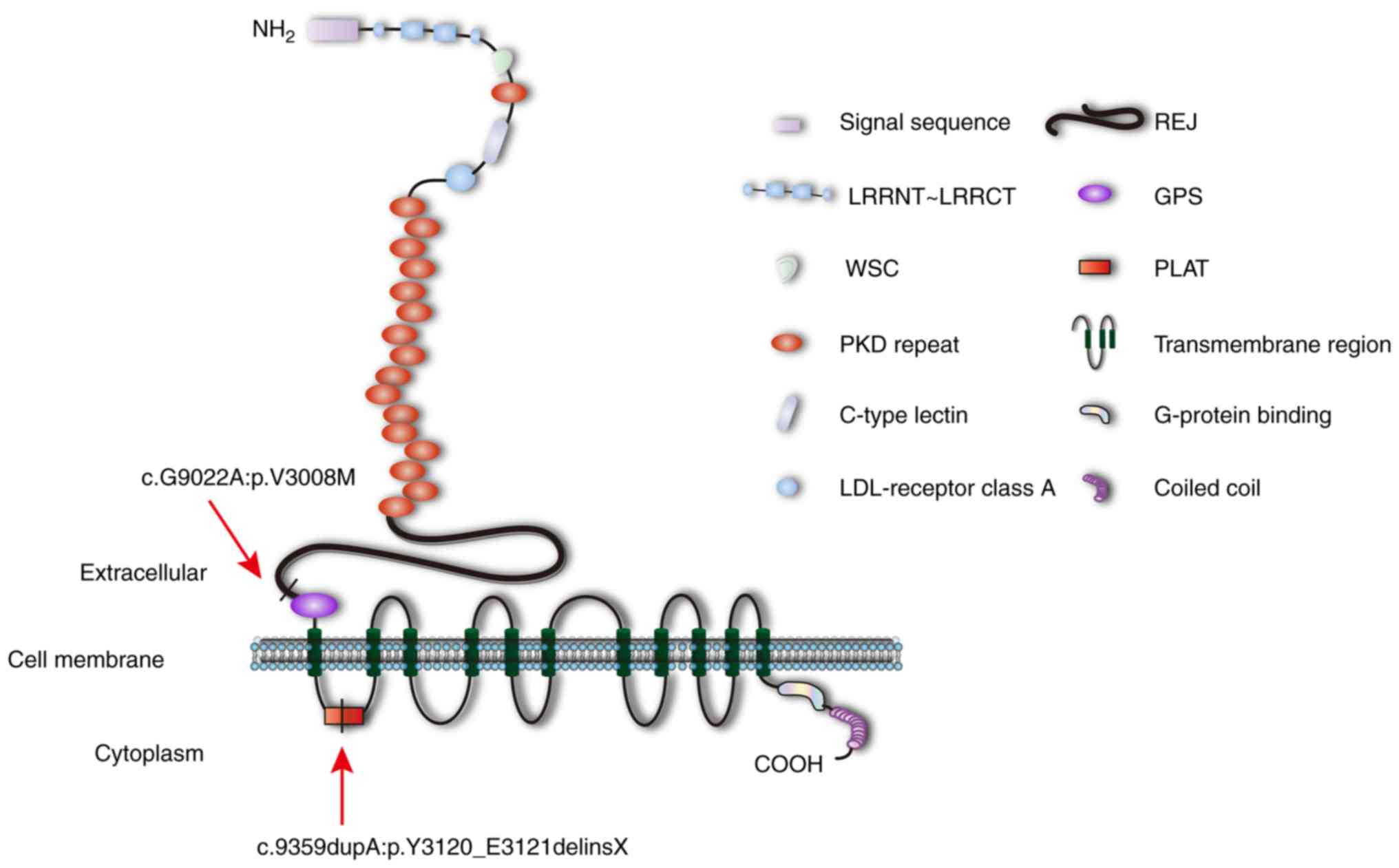|
1
|
Obeidova L, Elisakova V, Stekrova J,
Reiterova J, Merta M, Tesar V, Losan F and Kohoutova M: Novel
mutations of PKD genes in the Czech population with autosomal
dominant polycystic kidney disease. BMC Med Genet. 15:412014.
View Article : Google Scholar : PubMed/NCBI
|
|
2
|
Edrees BM, Athar M, Abduljaleel Z,
Al-Allaf FA, Taher MM, Khan W, Bouazzaoui A, Al-Harbi N, Safar R,
Al-Edressi H, et al: Functional alterations due to amino acid
changes and evolutionary comparative analysis of ARPKD and ADPKD
genes. Genom Data. 10:127–134. 2016. View Article : Google Scholar : PubMed/NCBI
|
|
3
|
Robinson C, Hiemstra TF, Spencer D, Waller
S, Daboo L, Karet Frankl FE and Sandford RN: Clinical utility of
PKD2 mutation testing in a polycystic kidney disease cohort
attending a specialist nephrology out-patient clinic. BMC Nephrol.
13:792012. View Article : Google Scholar : PubMed/NCBI
|
|
4
|
Abdelwahed M, Hilbert P, Ahmed A, Mahfoudh
H, Bouomrani S, Dey M, Hachicha J, Kamoun H, Keskes-Ammar L and
Belguith N: Mutational analysis in patients with Autosomal Dominant
Polycystic Kidney Disease (ADPKD): Identification of five mutations
in the PKD1 gene. Gene. May 31–2018.(Epub ahead of print).
View Article : Google Scholar : PubMed/NCBI
|
|
5
|
Yu G, Qian X, Wu Y, Li X, Chen J, Xu J and
Qi J: Analysis of gene mutations in PKD1/PKD2 by multiplex
ligation-dependent probe amplification: Some new findings. Ren
Fail. 37:366–371. 2015. View Article : Google Scholar : PubMed/NCBI
|
|
6
|
Litvinchuk T, Tao Y, Singh R and Vasylyeva
TL: A case of new familiar genetic variant of autosomal dominant
polycystic kidney disease-2: A case study. Front Pediatr. 3:822015.
View Article : Google Scholar : PubMed/NCBI
|
|
7
|
Casteleijn NF, Spithoven EM, Rookmaaker
MB, Vergouwen MD and Gansevoort RT: Bilateral cysts in the choroid
plexus in a patient with autosomal dominant polycystic kidney
disease. Nephrol Dial Transplant. 30:859–860. 2015. View Article : Google Scholar : PubMed/NCBI
|
|
8
|
Liu B, Chen SC, Yang YM, Yan K, Qian YQ,
Zhang JY, Hu YT, Dong MY, Jin F, Huang HF and Xu CM: Identification
of novel PKD1 and PKD2 mutations in a Chinese population with
autosomal dominant polycystic kidney disease. Sci Rep. 5:174682015.
View Article : Google Scholar : PubMed/NCBI
|
|
9
|
Hafer AS and Conran RM: Autosomal
recessive polycystic kidney disease. Acad Pathol.
4:23742895177185602017. View Article : Google Scholar : PubMed/NCBI
|
|
10
|
Thomas C, Zühlsdorf A, Hörtnagel K,
Mulahasanovic L, Grauer OM, Kümpers P, Wiendl H and Meuth SG: A
novel PKD1 mutation associated with autosomal dominant kidney
disease and cerebral cavernous malformation. Front Neurol.
9:3832018. View Article : Google Scholar : PubMed/NCBI
|
|
11
|
Somlo S, Wirth B, Germino GG,
Weinstat-Saslow D, Gillespie GA, Himmelbauer H, Steevens L, Coucke
P, Willems P, Bachner L, et al: Fine genetic localization of the
gene for autosomal dominant polycystic kidney disease (PKD1) with
respect to physically mapped markers. Genomics. 13:152–158. 1992.
View Article : Google Scholar : PubMed/NCBI
|
|
12
|
Gainullin VG, Hopp K, Ward CJ, Hommerding
CJ and Harris PC: Polycystin-1 maturation requires polycystin-2 in
a dose-dependent manner. J Clin Invest. 125:607–620. 2015.
View Article : Google Scholar : PubMed/NCBI
|
|
13
|
Kim DY and Park JH: Genetic mechanisms of
ADPKD. Adv Exp Med Biol. 933:13–22. 2016. View Article : Google Scholar : PubMed/NCBI
|
|
14
|
Shin YB and Park JH: Recent trends in
ADPKD research. Adv Exp Med Biol. 933:3–11. 2016. View Article : Google Scholar : PubMed/NCBI
|
|
15
|
Yang Y and Ehrlich BE: Structural studies
of the C-terminal tail of polycystin-2 (PC2) reveal insights into
the mechanisms used for the functional regulation of PC2. J
Physiol. 594:4141–4149. 2016. View
Article : Google Scholar : PubMed/NCBI
|
|
16
|
Venugopal J and Blanco G: On the many
actions of ouabain: Pro-cystogenic effects in autosomal dominant
polycystic kidney disease. Molecules. 22:E7292017. View Article : Google Scholar : PubMed/NCBI
|
|
17
|
Rangan GK, Lopez-Vargas P, Nankivell BJ,
Tchan M, Tong A, Tunnicliffe DJ and Savige J: Autosomal dominant
polycystic kidney disease: A path forward. Semin Nephrol.
35:524–537. 2015. View Article : Google Scholar : PubMed/NCBI
|
|
18
|
Saigusa T and Bell PD: Molecular pathways
and therapies in autosomal-dominant polycystic kidney disease.
Physiology (Bethesda). 30:195–207. 2015.PubMed/NCBI
|
|
19
|
Ong AC and Harris PC: A polycystin-centric
view of cyst formation and disease: The polycystins revisited.
Kidney Int. 88:699–710. 2015. View Article : Google Scholar : PubMed/NCBI
|
|
20
|
Santoso NG, Cebotaru L and Guggino WB:
Polycystin-1, 2, and STIM1 interact with IP(3)R to modulate ER Ca
release through the PI3K/Akt pathway. Cell Physiol Biochem.
27:715–726. 2011. View Article : Google Scholar : PubMed/NCBI
|
|
21
|
Yamaguchi T, Wallace DP, Magenheimer BS,
Hempson SJ, Grantham JJ and Calvet JP: Calcium restriction allows
cAMP activation of the B-Raf/ERK pathway, switching cells to a
cAMP-dependent growth-stimulated phenotype. J Biol Chem.
279:40419–40430. 2004. View Article : Google Scholar : PubMed/NCBI
|
|
22
|
Yamaguchi T, Pelling JC, Ramaswamy NT,
Eppler JW, Wallace DP, Nagao S, Rome LA, Sullivan LP and Grantham
JJ: cAMP stimulates the in vitro proliferation of renal cyst
epithelial cells by activating the extracellular signal-regulated
kinase pathway. Kidney Int. 57:1460–1471. 2000. View Article : Google Scholar : PubMed/NCBI
|
|
23
|
Rossetti S, Kubly VJ, Consugar MB, Hopp K,
Roy S, Horsley SW, Chauveau D, Rees L, Barratt TM, van't Hoff WG,
et al: Incompletely penetrant PKD1 alleles suggest a role for gene
dosage in cyst initiation in polycystic kidney disease. Kidney Int.
75:848–855. 2009. View Article : Google Scholar : PubMed/NCBI
|
|
24
|
Nagao S, Nishii K, Yoshihara D, Kurahashi
H, Nagaoka K, Yamashita T, Takahashi H, Yamaguchi T, Calvet JP and
Wallace DP: Calcium channel inhibition accelerates polycystic
kidney disease progression in the Cy/+ rat. Kidney Int. 73:269–277.
2008. View Article : Google Scholar : PubMed/NCBI
|
|
25
|
Ghata J and Cowley BD Jr: Polycystic
kidney disease. Compr Physiol. 7:945–975. 2017. View Article : Google Scholar : PubMed/NCBI
|
|
26
|
Trudel M, Yao Q and Qian F: The role of
G-protein-coupled receptor proteolysis site cleavage of
polycystin-1 in renal physiology and polycystic kidney disease.
Cells. 5:E32016. View Article : Google Scholar : PubMed/NCBI
|
|
27
|
Chapin HC, Rajendran V and Caplan MJ:
Polycystin-1 surface localization is stimulated by polycystin-2 and
cleavage at the G protein-coupled receptor proteolytic site. Mol
Biol Cell. 21:4338–4348. 2010. View Article : Google Scholar : PubMed/NCBI
|
|
28
|
Li H, Handsaker B, Wysoker A, Fennell T,
Ruan J, Homer N, Marth G, Abecasis G and Durbin R; 1000 Genome
Project Data Processing Subgroup, : The Sequence Alignment/Map
format and SAMtools. Bioinformatics. 25:2078–2079. 2009. View Article : Google Scholar : PubMed/NCBI
|
|
29
|
Al-Bhalal L and Akhtar M: Molecular basis
of autosomal dominant polycystic kidney disease. Adv Anat Pathol.
12:126–133. 2005. View Article : Google Scholar : PubMed/NCBI
|
|
30
|
Gout AM, Martin NC, Brown AF and Ravine D:
PKDB: Polycystic kidney disease mutation database-a gene variant
database for autosomal dominant polycystic kidney disease. Hum
Mutat. 28:654–659. 2007. View Article : Google Scholar : PubMed/NCBI
|
|
31
|
Dedoussis GV, Luo Y, Starremans P,
Rossetti S, Ramos AJ, Cantiello HF, Katsareli E, Ziroyannis P,
Lamnissou K, Harris PC and Zhou J: Co-inheritance of a PKD1
mutation and homozygous PKD2 variant: A potential modifier in
autosomal dominant polycystic kidney disease. Eur J Clin Invest.
38:180–190. 2008. View Article : Google Scholar : PubMed/NCBI
|
|
32
|
Cornec-Le Gall E, Audrézet MP, Chen JM,
Hourmant M, Morin MP, Perrichot R, Charasse C, Whebe B, Renaudineau
E, Jousset P, et al: Type of PKD1 mutation influences renal outcome
in ADPKD. J Am Soc Nephrol. 24:1006–1013. 2013. View Article : Google Scholar : PubMed/NCBI
|
|
33
|
Neumann HP, Bacher J, Nabulsi Z, Ortiz
Brüchle N, Hoffmann MM, Schaeffner E, Nürnberger J, Cybulla M,
Wilpert J, Riegler P, et al: Adult patients with sporadic
polycystic kidney disease: The importance of screening for
mutations in the PKD1 and PKD2 genes. Int Urol Nephrol.
44:1753–1762. 2012. View Article : Google Scholar : PubMed/NCBI
|
|
34
|
Yu C, Yang Y, Zou L, Hu Z, Li J, Liu Y, Ma
Y, Ma M, Su D and Zhang S: Identification of novel mutations in
Chinese Hans with autosomal dominant polycystic kidney disease. BMC
Med Genet. 12:1642011. View Article : Google Scholar : PubMed/NCBI
|
|
35
|
Kinoshita M, Higashihara E, Kawano H,
Higashiyama R, Koga D, Fukui T, Gondo N, Oka T, Kawahara K, Rigo K,
et al: Technical evaluation: Identification of pathogenic mutations
in PKD1 and PKD2 in patients with autosomal dominant polycystic
kidney disease by next-generation sequencing and use of a
comprehensive new classification system. PLoS One. 11:e01662882016.
View Article : Google Scholar : PubMed/NCBI
|
|
36
|
Liu J, Li L and Liu Q: Mutational analysis
of PKD1 gene in a Chinese family with autosomal dominant polycystic
kidney disease. Int J Clin Exp Pathol. 8:13289–13292.
2015.PubMed/NCBI
|
|
37
|
Carrera P, Calzavara S, Magistroni R, den
Dunnen JT, Rigo F, Stenirri S, Testa F, Messa P, Cerutti R, Scolari
F, et al: Deciphering variability of PKD1 and PKD2 in an italian
cohort of 643 patients with autosomal dominant polycystic kidney
disease (ADPKD). Sci Rep. 6:308502016. View Article : Google Scholar : PubMed/NCBI
|
|
38
|
Sha YK, Sha YW, Mei LB, Huang XJ, Wang X,
Lin SB, Li L and Li P: Use of targeted sequence capture and
high-throughput sequencing identifies a novel PKD1 mutation
involved in adult polycystic kidney disease. Gene. 634:1–4. 2017.
View Article : Google Scholar : PubMed/NCBI
|
|
39
|
Mallawaarachchi AC, Furlong TJ, Shine J,
Harris PC and Cowley MJ: Population data improves variant
interpretation in autosomal dominant polycystic kidney disease.
Genet Med. Oct 29–2018.(Epub ahead of print). doi:
10.1038/s41436-018-0324-x. View Article : Google Scholar : PubMed/NCBI
|













